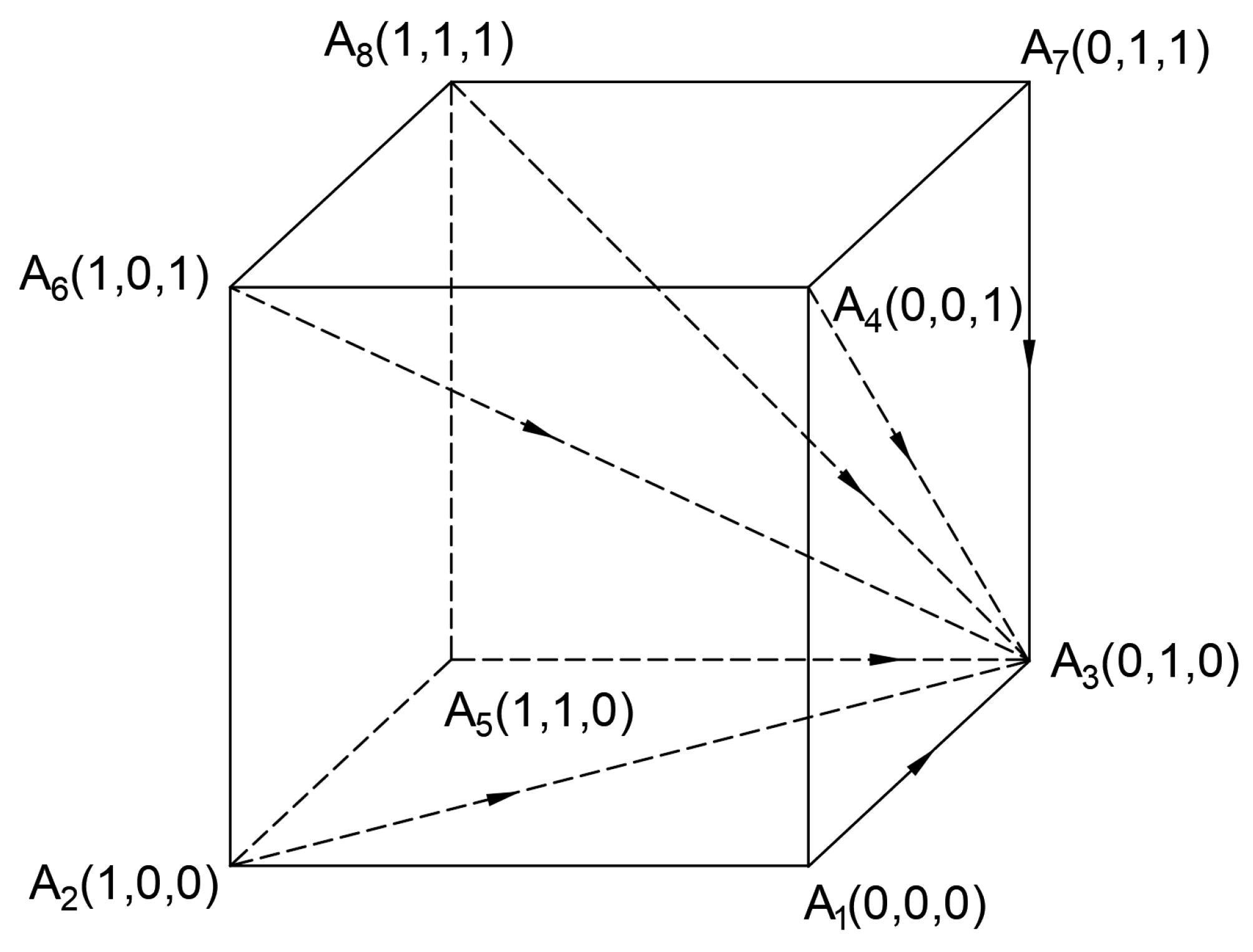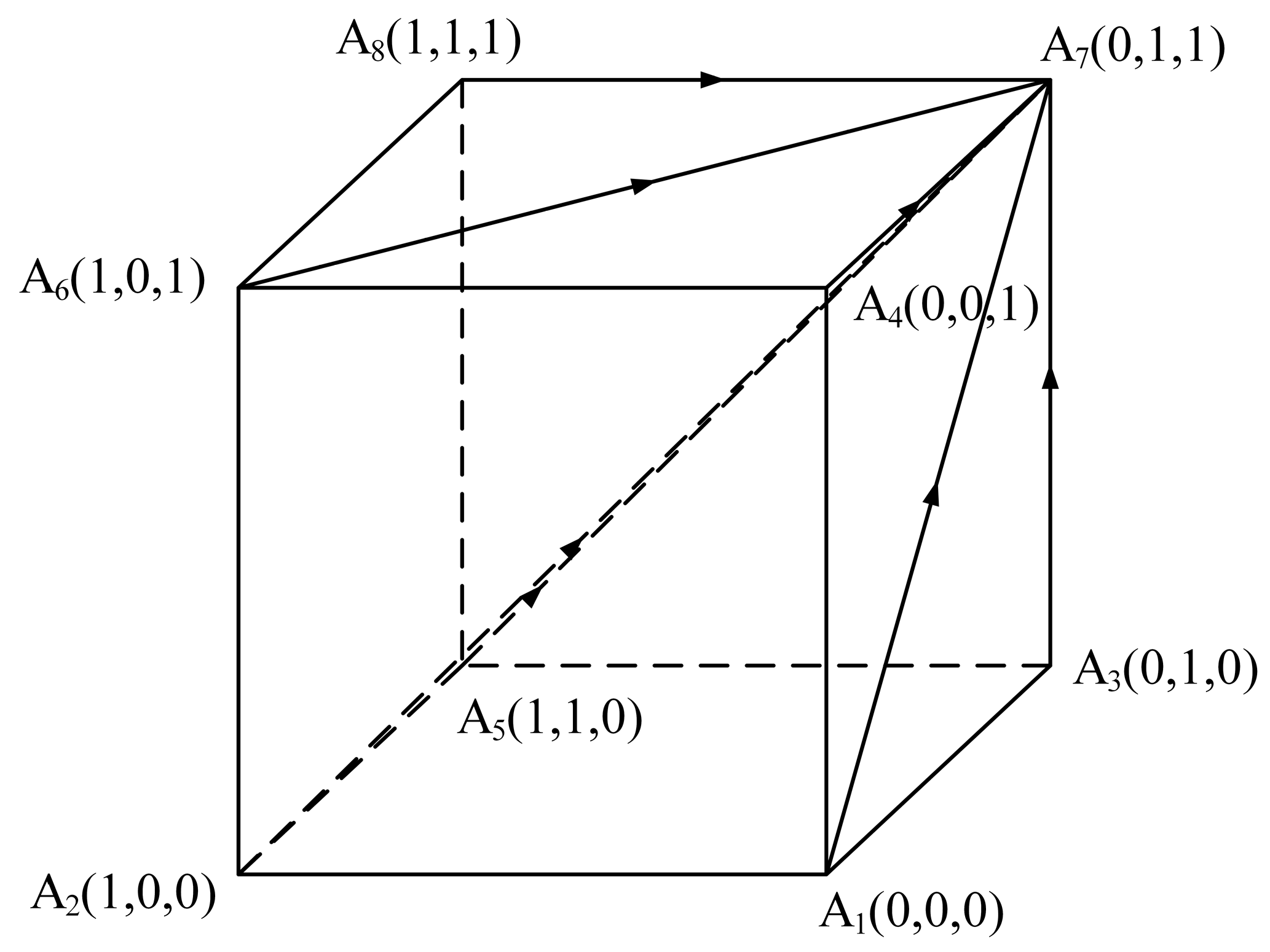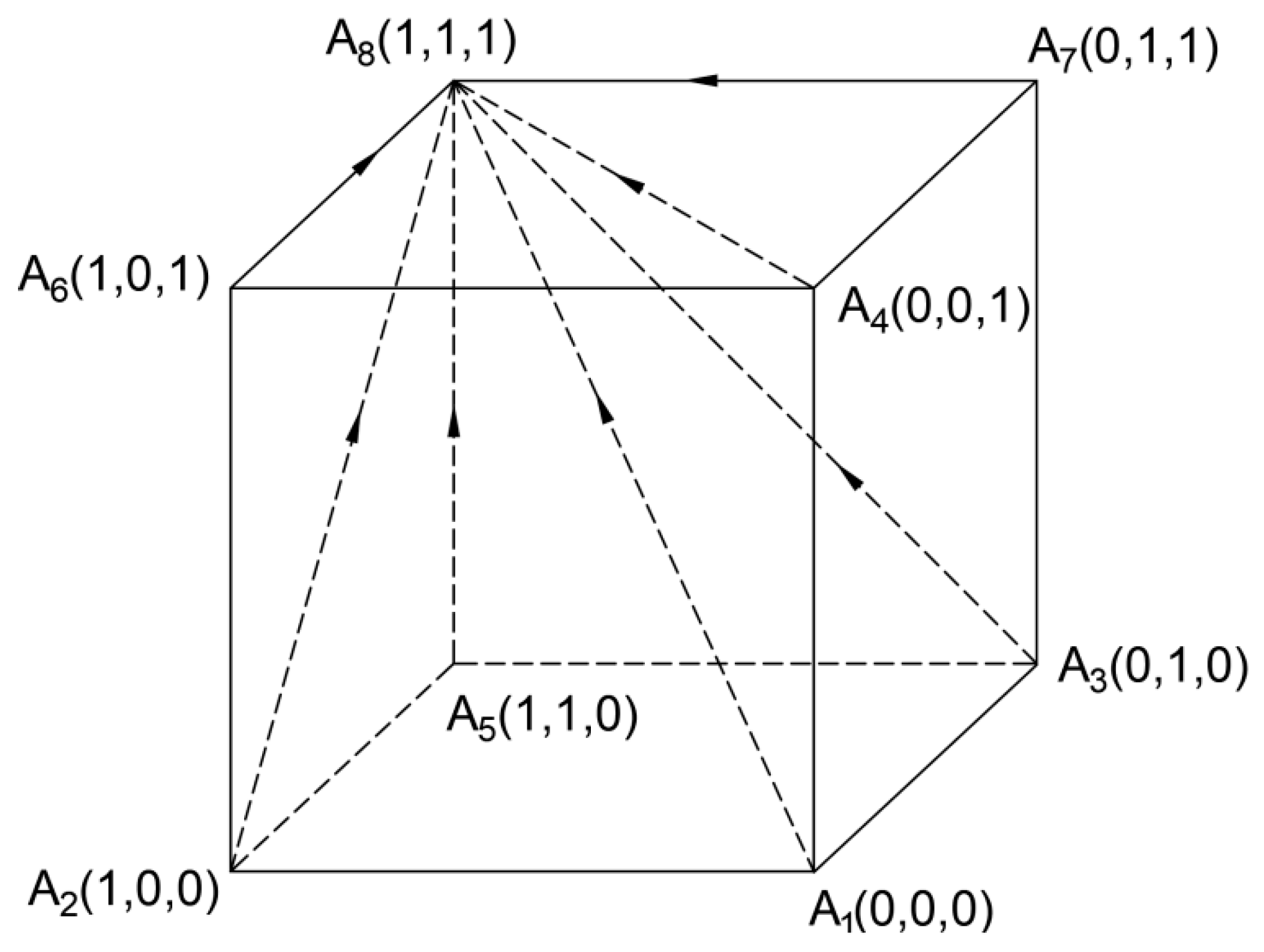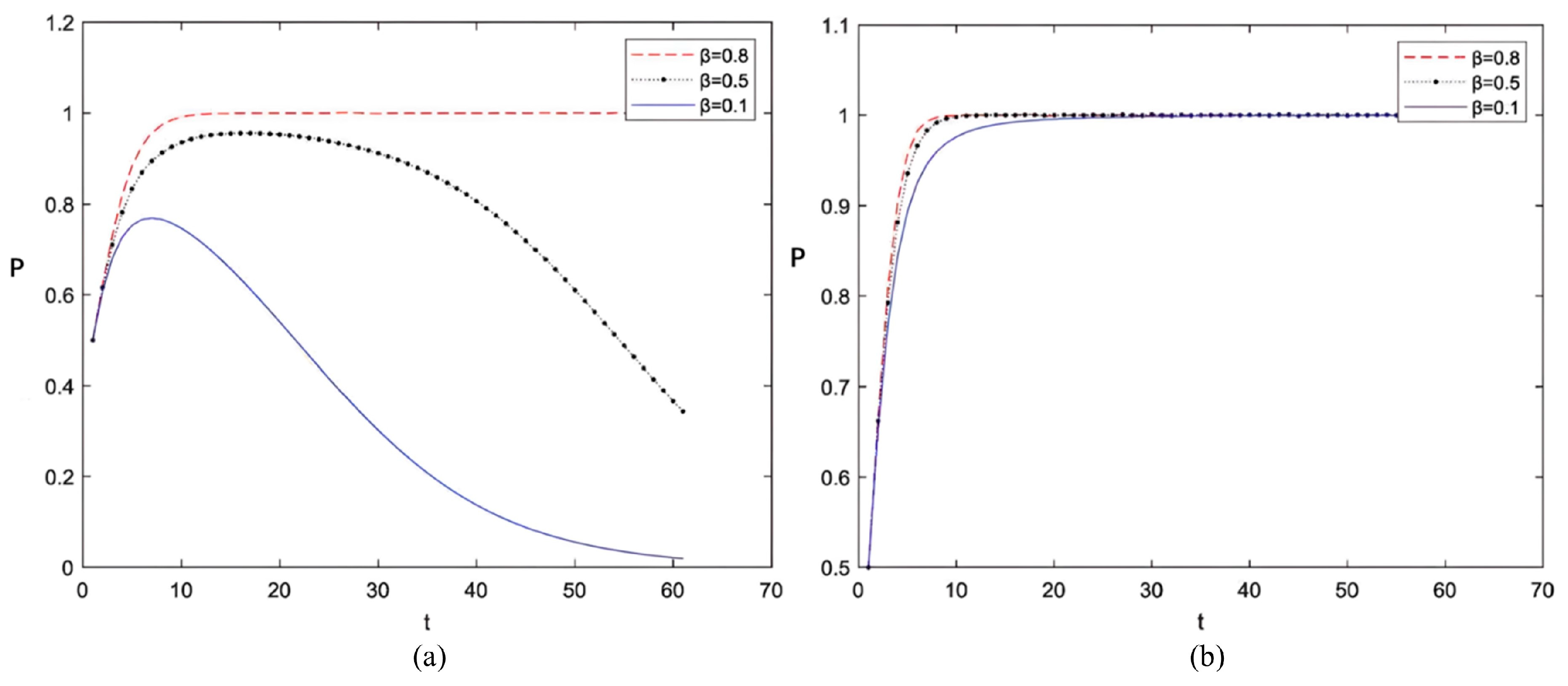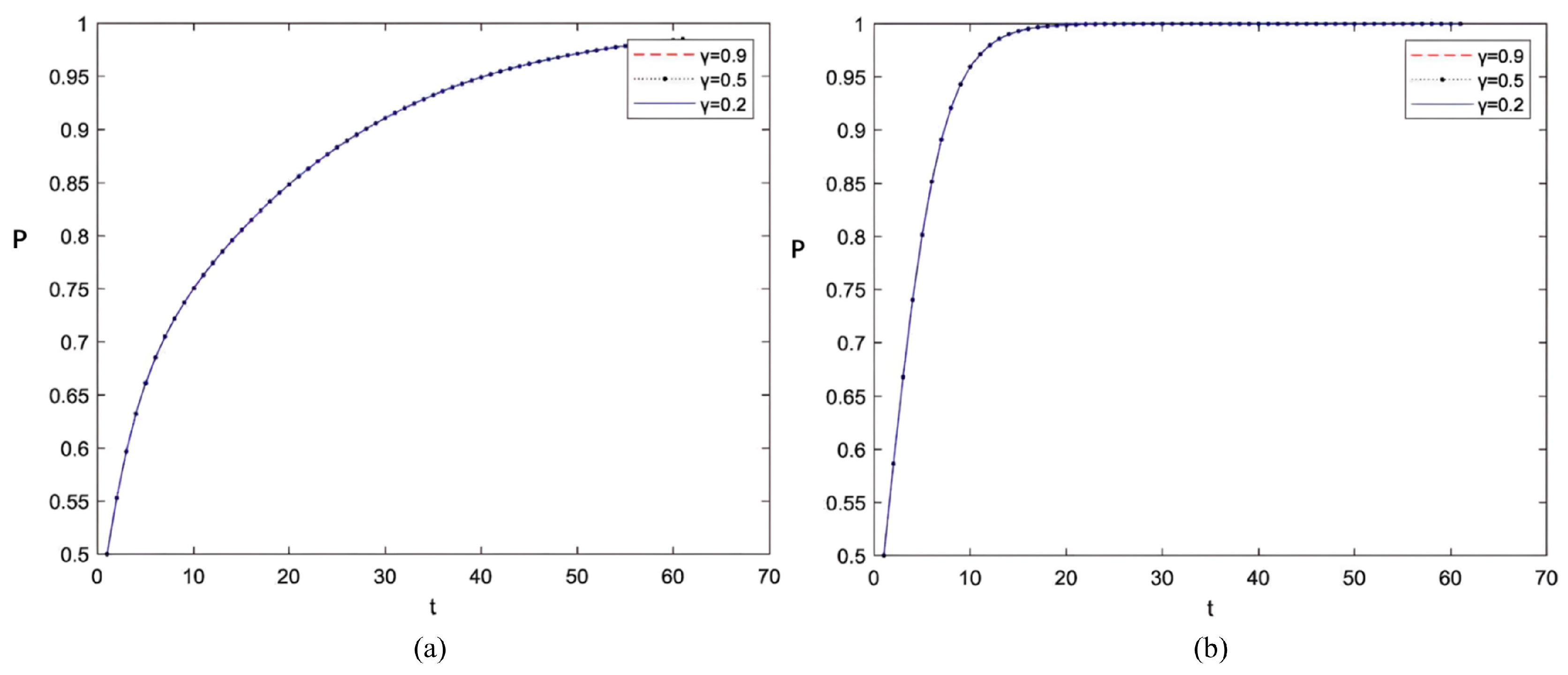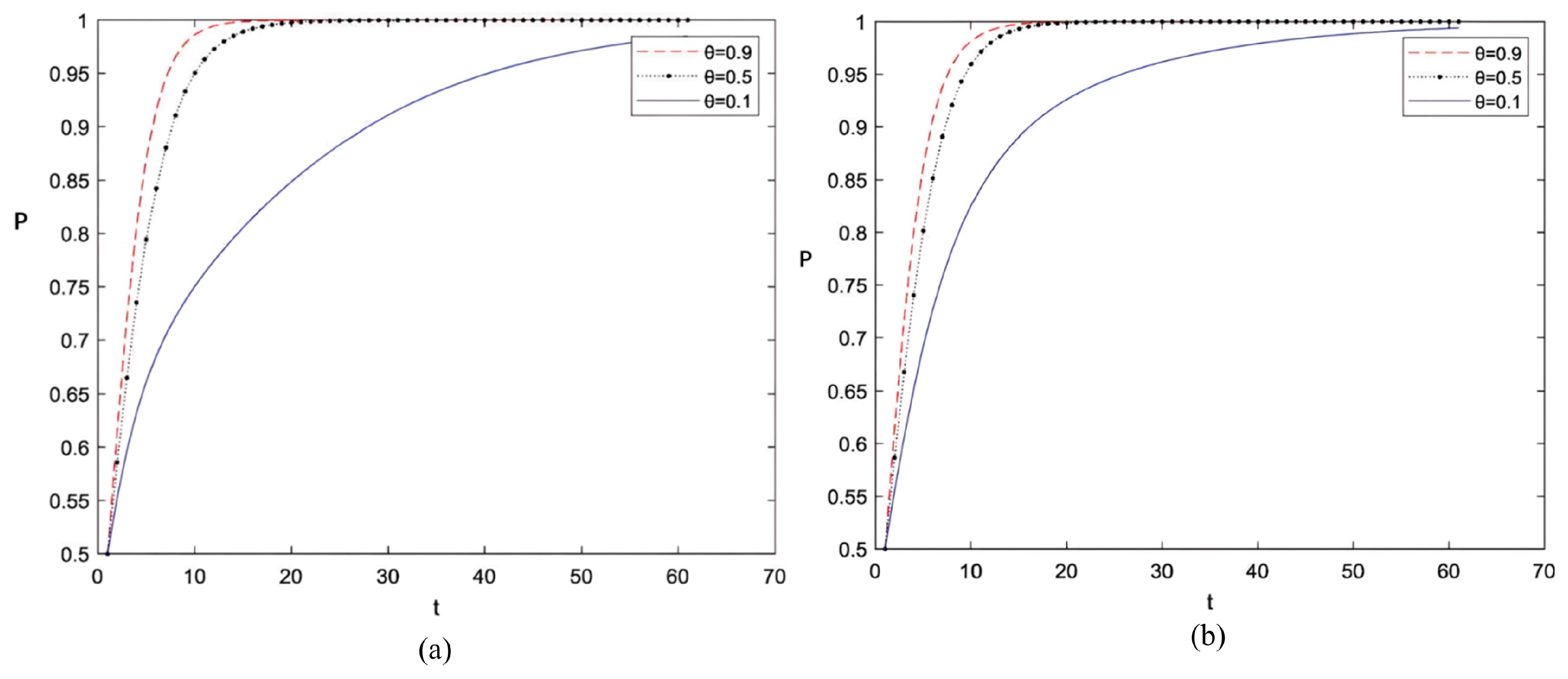3.1. Analysis of Strategy Selection Among Various Behavioral Agents
In the game model of government regulation, the key players are logistics enterprises, the government, and consumers. Among them, logistics enterprises have two strategic choices. The first is to adopt low-carbon operations, committed to reducing carbon emissions and environmental pollution; The second is to choose non-low-carbon operations, which may not adopt low-carbon measures due to cost or technology. Governments need to balance positive and negative regulation. Consumers, on the other hand, face two decisions: to consume and not to consume. These three players are interrelated and influence each other in the game process. Their strategy choices will directly determine the game’s final result and the distribution of each party’s interests. Therefore, an in-depth analysis of the strategic decisions of these three subjects and their influencing factors is of great significance for promoting the development of low-carbon logistics and optimizing government regulatory strategies.
3.1.1. Game Between Logistics Enterprises and Consumers
The game between logistics enterprises and consumers is a complicated and subtle interactive process in which logistics cost and efficiency play a crucial role. This kind of game involves the operation strategy of logistics enterprises and directly relates to consumers’ purchase intention and market choice. In logistics, cost and efficiency are critical indicators to measure the competitiveness of an enterprise. When the logistics cost rises to a high level or the logistics operation efficiency is not satisfactory, consumers’ desire for a specific type of goods may be significantly impacted, affecting their purchase decisions. High logistics costs may lead to higher commodity prices, reducing consumers’ purchasing power. Inefficient logistics can mean delays in the delivery of goods, affecting consumers’ shopping experience. Therefore, while pursuing low-carbon development, logistics enterprises must fully consider cost and efficiency factors to ensure their competitiveness in the market.
As a new logistics model, low-carbon logistics aims to improve logistics efficiency and reduce costs while reducing energy consumption and carbon emissions. However, achieving this goal will not be easy. Low-carbon logistics may require logistics enterprises to adopt more environmentally friendly but more costly transportation methods and packaging materials, which may increase logistics costs to a certain extent. At the same time, implementing low-carbon logistics may also require logistics enterprises to upgrade technology and optimize processes to improve logistics efficiency. These changes will eventually be reflected in the price of goods and the timeliness of logistics, thus affecting consumers’ purchasing decisions. In this process, consumers play a crucial role. They will evaluate the cost and efficiency of logistics according to the products and services logistics enterprises provide to make consumption decisions. Suppose consumers recognize and support the low-carbon strategy of logistics enterprises. In that case, they may be more inclined to buy related goods, which will help logistics enterprises improve their market share and profit level. On the contrary, if consumers are skeptical or pessimistic about the low-carbon strategy of logistics companies, they may choose other, more competitive goods or services, which will bring pressure and challenges to logistics companies.
Therefore, when choosing whether to adopt the low-carbon strategy, logistics enterprises must fully consider the game relationship between them and consumers. They need to reduce the cost increase brought about by low-carbon logistics through technological innovation and process optimization while improving logistics efficiency and service quality to win the trust and support of consumers. At the same time, logistics enterprises must also pay close attention to market dynamics and consumer demand changes and flexibly adjust their strategies to adapt to the changing market environment.
3.1.2. Game Between Logistics Enterprises and the Government
The game between logistics enterprises and the government concerns environmental protection, economic development, and social responsibility. In this three-party game, logistics enterprises, as the core role, need to actively integrate social resources, strengthen the construction of logistics personnel, and make full use of information technology to promote the rapid low-carbon development of the logistics industry. As a regulatory department, the government must choose between the two strategies of positive supervision and harmful supervision to guide logistics enterprises to the road of low-carbon development. For logistics enterprises, implementing a low-carbon logistics strategy is conducive to reducing energy consumption and carbon emissions, improving logistics efficiency, and helping enterprises reduce costs and enhance market competitiveness. However, logistics enterprises face many challenges while implementing a low-carbon logistics strategy. For example, the research and development and application of low-carbon technologies require a large amount of capital investment and human support, which is undoubtedly a significant pressure on cash-strapped logistics enterprises with a talent shortage. In addition, implementing a low-carbon logistics strategy may also lead to increased operating costs and reduced logistics timeliness, which will have a particular impact on logistics enterprises’ business development and market competitiveness.
In this context, the role of government is vital. If the government adopts an active regulatory strategy, it will strictly evaluate the carbon emissions of logistics enterprises and encourage them to adopt low-carbon strategies through rewards and penalties. At the same time, the government will increase investment in low-carbon technology research and development, plan corresponding logistics parks, strengthen infrastructure construction, and fully support logistics enterprises in implementing low-carbon strategies to promote the green transformation of the industry. These initiatives help facilitate the transformation of logistics enterprises to low-carbon production and improve the awareness of environmental protection and sustainable development of society. However, suppose the government chooses a negative regulatory strategy and relaxes the regulation on the carbon emissions of logistics enterprises. In that case, the corresponding support and guarantee will also be reduced, which may hurt the development of low-carbon logistics. In this case, logistics companies may find it challenging to take the initiative to implement low-carbon strategies due to a lack of external pressure and motivation. At the same time, due to the reduction of government support, logistics enterprises may face more difficulties and challenges in the process of implementing low-carbon strategies. Therefore, the game between logistics enterprises and the government is a contest of economic interests and a test of environmental protection and social responsibility. In this game, the two sides must cooperate closely to achieve the sustainable development of low-carbon logistics. The government should strengthen the supervision and guidance of logistics enterprises and provide necessary support and guarantees. Logistics enterprises should actively respond to the government’s call, increase investment in the research and development and application of low-carbon technology, and constantly improve their environmental awareness and social responsibility.
3.1.3. Game Between Consumers and Government
The game between consumers and the government is particularly complex and delicate in low-carbon logistics. The role of government is not only as a regulator and facilitator but also as an essential force in promoting sustainable development. When the government actively regulates, encourages, and supports the development of low-carbon logistics through low-carbon subsidies and tax incentives, this strategy tends to promote consumers’ purchase willingness. This is because government subsidies and tax incentives reduce the price of goods and increase consumers’ purchasing power while also signaling to consumers that the government is committed to promoting environmental protection and sustainable development. In this case, consumers are more inclined to buy goods that meet low-carbon standards, not only because the price of the goods is more reasonable but also because they want their consumption behavior to be consistent with the government’s environmental goals. This change in consumer behavior will undoubtedly positively impact the logistics market and promote logistics enterprises to increase investment in low-carbon technologies and services, forming a virtuous circle.
However, if the government chooses to negatively regulate and allow the free development of the logistics market, the rights and interests of consumers may be affected by the promotion of low-carbon logistics. For example, logistics companies may reduce the quality of services due to a lack of regulation, leading to problems such as delayed or damaged delivery of goods. Since logistics companies’ carbon emissions are not effectively regulated, consumers may stop or reduce consumption to protect their rights and interests. Given that the government’s goal is to ensure the stability and prosperity of the logistics market, consumer purchasing behavior is a crucial factor affecting the strength and intensity of government regulation. Specifically, when consumers show a strong propensity to buy, the government is more motivated to strengthen regulation and provide subsidies and incentives to promote market development further. This logical chain shows that consumers’ purchase behavior is not only related to personal rights and interests but also an essential factor in government regulation and market development. Conversely, if consumers are less willing to buy, the government may need to re-evaluate its regulatory strategy and find more effective measures to stimulate market vitality.
The game between the government and consumers is a process of mutual influence and restriction. The government’s regulatory strategy and consumers’ purchasing behavior jointly shape the development track of the logistics market. In this process, achieving balance and coordination between the government, consumers, and logistics enterprises to promote the sustainable development of low-carbon logistics will be a problem that we must continue exploring and solving.
3.4. Tripartite Evolutionary Game Simulation Analysis
In the process of in-depth research on low-carbon logistics strategies, we refer to relevant literature such as Ran et al. (2024) [
39] and Wang et al. (2024a) [
40] and Wu et al. (2024) [
41]. Based on the simulation parameters of government participation and other behavioral dynamics obtained by Balm (2022) [
42] and Li et al. (2024b) [
43] through a questionnaire survey, the relevant parameters of this study were developed, as shown in
Table 3. To further explore the government’s regulatory strategy of low-carbon logistics from the perspective of evolutionary game. In this section, the ODE45 function in MATLAB R2023b is used to simulate the numerical solution of the ordinary differential equation. Based on the simulation results, the paper discusses several aspects of the government’s low-carbon incentive mechanism, including research and development intensity, construction intensity, and punishment intensity. Simulation parameter Settings are shown in
Table 3:
Assume that the common parameter values are I = 3, F = 3, P = 3, T = 50, R1 = 60, c1 = 50, R2 = 50, c2 = 15, R3 = 10, c3 = 6, R4 = 20, r1 = 7, r2 = 5.
When
is set as high, medium, and low forces, respectively, and both gamma and theta are set as low forces, the path of the evolutionary game is shown in
Figure 5a,
Figure 6a,
Figure 7a and
Figure 8a, respectively. When
maintains three different forces and
and
are adjusted to medium forces,
Figure 5b,
Figure 6b,
Figure 7b and
Figure 8b show the corresponding evolutionary game path. Further, when
takes high, medium and low R&D intensity respectively, while
and
all reach high intensity, the evolution paths of government, logistics enterprises and consumers are shown in
Figure 5c and
Figure 6c respectively. It is worth noting that when both y and o maintain moderate strength, the evolutionary paths of consumers and government show consistency.
Figure 5a shows the path of the tripartite evolutionary game when
and
are both set at low forces. It is particularly worth noting that when the government’s financial funds for R&D investment are high, logistics enterprises show a solid tendency towards low-carbon, and consumers’ spending power is also significantly improved, fully demonstrating the remarkable effect of government R&D investment. This result is consistent with discussion 3 in the stability analysis. However, suppose the government provides a medium or low financial R&D investment in low-carbon technologies. In that case, logistics enterprises choose non-low-carbon strategies, and consumers tend not to consume, consistent with discussion 1 in the stability analysis. These simulation results provide essential insights into the impact of government R&D investment on logistics firms and consumer behavior.
According to the tripartite evolutionary game path graph shown in
Figure 5b, it can be concluded that when both
and
are of medium intensity, logistics enterprises are more likely to adopt a low-carbon strategy if the government’s financial investment in low-carbon technology R&D of logistics enterprises is kept at a high or medium level. At the same time, the impact of government R&D investment will be particularly significant if consumer purchasing power increases. This simulation result is consistent with the previous discussion 3 and further confirms the considerable effect of government R&D investment on logistics firms and consumer behavior. However, when the financial R&D investment provided by the government is low, only logistics enterprises are gradually inclined to non-low-carbon strategies. This is because in this context, the values of
and
ensure the effectiveness of government supervision and the satisfaction of consumer demand, thus maintaining the stability of the market and policies. This finding is consistent with discussion 2 in the stability analysis.
When
and
both reach high strength levels, the evolutionary game paths shown in
Figure 5c significantly differ from those shown in
Figure 5b. Even if the government’s investment in research and development of low-carbon logistics technology remains low, logistics enterprises will still choose a low-carbon development path. This simulation result is consistent with the discussion of stability analysis 3. It highlights the comprehensive effect of government research and development, construction, and supervision in promoting the development of low-carbon logistics. This phenomenon also occurs in reality. In recent years, as green consumption awareness has grown, logistics enterprises have increasingly shifted toward low-carbon models, even in the absence of strong R&D incentives, to meet market demand and build a green brand image.
When
and
are both of low intensity, the evolution path of logistics enterprises is shown in
Figure 6a. When there is little or no government investment in low-carbon R&D, logistics companies are more likely to choose non-low-carbon strategies. It is worth noting that even in the case of high R&D intensity, logistics enterprises choose low-carbon strategies that are relatively few. This shows that if the government’s research and development efforts are insufficient, the comprehensive factors, such as the intensity of its infrastructure construction and the intensity of punishment for non-low-carbon enterprises will become the key factors affecting whether logistics enterprises adopt low-carbon strategies. Therefore, when promoting the development of low-carbon logistics, the government must consider various strategies comprehensively to ensure the formation of practical, comprehensive effects.
When
and
are both at the medium strength level, the evolution path of logistics enterprises is shown in
Figure 6b. Compared to the scenario shown in
Figure 6a, there is one clear difference: the government provides a moderate level of R&D investment, while logistics companies opt for a low-carbon strategy. When the R&D investment is high, the time for logistics enterprises to choose a low-carbon strategy is shorter than when the R&D investment is significant. The reasons for this phenomenon are closely related to the high cost of low-carbon logistics and the complexity of processing technology. Government investment in research and development helps reduce the transition cost to low-carbon logistics and stimulates technological innovation, effectively promoting the overall development of low-carbon logistics.
When
and
both reach a high intensity, the evolution path of logistics enterprises is shown in
Figure 6c, although in the early stage of the government’s low R&D efforts, enterprises tend to choose non-low-carbon strategies, and although the government’s investment in low-carbon R&D is limited, logistics enterprises still tend to select low-carbon strategies after weighing the advantages and disadvantages due to the government’s massive investment in logistics infrastructure construction and the severe punishment for non-low-carbon enterprises. By comparing the results of
Figure 6a,b, it can be seen that when the government’s punishment measures and construction activities work together, the impact on the strategic choice of logistics enterprises is more significant than that solely dependent on R&D investment. This shows that in promoting the development of low-carbon logistics, in addition to research and development investment, the government also needs to pay attention to improving infrastructure construction and supervision to form a more effective comprehensive effect.
A comparison of
Figure 7a,b shows that regardless of the intensity of R&D, construction, and penalties, the government ultimately adopts an aggressive regulatory strategy. In particular, the government’s development path has changed significantly with the rise of
and
from low to moderate intensity levels. It is worth noting that with the increase in research and development efforts, the government is inclined to accelerate development and shift to a proactive regulatory strategy. This phenomenon highlights the critical role of government regulation in promoting the low-carbon development of logistics. It confirms the discussion of stability analysis 4, which jointly supports the necessity and effectiveness of the government’s active regulatory strategy.
Figure 8a shows the evolution path of consumers at low-intensity levels of gamma, and theta is found that only when the government’s research and development efforts reach a high level of intensity will consumers start to increase their consumption. This trend shows that government R&D efforts are vital in influencing consumer decisions. However, when the research and development efforts are at a medium or low level, although consumers are initially willing to consume, most eventually choose not to consume anymore. The reason behind this is that the negative attitude of government regulation makes it difficult for consumers to obtain enough additional benefits from low-carbon products to cover the cost of consumption.
When
and
are both in medium intensity, the evolution path of consumers is shown in
Figure 8b. Due to the effective guarantee of government construction and punishment, no matter how much government research and development efforts, consumers will eventually choose to consume.
When
and
are both at low-intensity levels, as shown in
Figure 9a,
Figure 10a,
Figure 11a and
Figure 12a, the evolutionary game path diagram of
under three different R&D intensity levels: high intensity (0.9), medium intensity (0.5) and low intensity (0.2) are studied in depth. Further, as shown in
Figure 9b,
Figure 10b,
Figure 11b and
Figure 12b, when
and
are biased to the medium level of strength, the evolutionary game path diagram is drawn correspondingly under three different R&D strengths: high, medium, and low. It is worth noting that when
and
both reach high dynamics, their evolutionary paths are similar to those at medium dynamics.
In the context of low intensity of
and
, as shown in
Figure 9a, when the government’s investment in logistics infrastructure construction is insufficient, logistics enterprises tend not to adopt low-carbon strategies, and consumers choose not to buy low-carbon products. This finding is consistent with discussion 1 in the stability analysis. However, when government investment in infrastructure reaches a certain threshold, consumers will buy low-carbon products instead. But it is worth noting that even in this case, logistics companies still tend not to adopt low-carbon strategies. This simulation result further validates the stability analysis in Discussion 2.
When the strengths of
and
are both medium, the path of the tripartite evolutionary game is shown in
Figure 9b. Regardless of whether the government’s financial investment in infrastructure construction is high or low, logistics enterprises tend to evolve towards low-carbon strategies while consumers’ consumption tendency continues to rise. It is worth noting that the pace of development of different construction scales has remained at similar levels, further highlighting the critical impact of government R&D investment. This simulation result confirms the stability analysis in Discussion 3. Compared with
Figure 9a, it can be seen that the combined effect of punishment and R&D intensity is usually vital in promoting low-carbon logistics. Still, when its intensity is insufficient, construction intensity becomes the key. These findings reflect structural challenges in the current low-carbon logistics transition—namely, the unbalanced allocation of fiscal resources among punishment, construction, and R&D, which hampers integrated progress. Therefore, the government should flexibly adjust its strategy according to the situation to maximize the effect of promoting low-carbon logistics.
Under the low and medium intensity scenario of
and
, the evolution path of logistics enterprises is shown in
Figure 10a,b. When the research and development intensity and punishment intensity increase from low to medium level, the strategic decisions of logistics enterprises with different construction intensities are very different. However, assuming that R&D and punishment intensity remain the same, the evolutionary game changes in the opposite direction. This phenomenon shows that punishment intensity
and R&D intensity
have a significant influence on whether enterprises choose low-carbon strategy but have no great influence on whether enterprises are affected by government construction intensity
. Therefore, when the government promotes the implementation of low-carbon strategies by logistics enterprises, it should focus on how to adjust the intensity of research and development and punishment, rather than just relying on increasing construction investment.
When
and
are both in low and medium-intensity situations,
Figure 11a,b show the comparative analysis of government evolutionary game paths. Through in-depth research, it is found that the government’s strategy of adopting active regulation has little relationship with the values of
,
and
. This simulation result is highly consistent with discussion 4 in the stability analysis, and once again emphasizes the key role of government regulation in promoting the development of low-carbon logistics. The different values of construction intensity
have no significant influence on the speed of the government’s relevant strategy selection. What impacts the speed of the government’s strategy choice is the change in the severity of punishment. Specifically, under low punishment and R&D intensity, the speed of government selection is significantly lower than that under medium R&D and punishment intensity.
In the scenario where
and
are in low and medium intensity respectively, the evolutionary game path of consumers is shown in
Figure 12a,b. When the government’s punishment and research and development efforts are kept at a low level, the government’s infrastructure construction efforts will affect whether consumers choose to consume. Specifically, consumers may be more inclined to spend if the government’s infrastructure is strong enough. On the other hand, if infrastructure construction is inadequate, consumers may be more inclined not to spend. Many factors influence consumers’ spending decisions. Initially, consumers may decide to consume, but over time, they will choose not to consume for a long time due to the imperfect and cumbersome logistics infrastructure. However, suppose the government’s R&D efforts and sanctions are increased to a moderate level. In that case, the level of government infrastructure development will not have a decisive impact on consumers’ final strategic decisions. However, it is worth noting that consumers take slightly less time to make consumption decisions at high levels of development than at low levels of development.
When subjected to three different punishment intensities of high force 0.9, medium force 0.5, and low force 0.1, Beta and gamma are reduced, and the evolutionary game path is shown in
Figure 13a,
Figure 14a,
Figure 15a and
Figure 16a. When
and
are changed to medium force, the evolutionary game path of
under three punishment forces is also analyzed, as shown in
Figure 13b,
Figure 14b,
Figure 15b and
Figure 16b. It is worth noting that under different punishment intensity, when
and
both reach high intensity, the evolution paths of the three parties and logistics enterprises are shown in
Figure 13c and
Figure 14c respectively. At this time, the evolution path of the government and consumers is the same as when
and
took the central power. The interaction and influence of various factors in the development of low-carbon logistics can be more deeply understood through a comparative analysis of the evolutionary game path under different parameter combinations.
Under the condition that both
and
are of low strength, the path of tripartite evolutionary game under different
values is shown in
Figure 13a. When the government imposes severe punishment on the non-low-carbon behavior of logistics enterprises, logistics enterprises gradually shift to low-carbon strategies, and consumers tend to increase consumption, which indicates that the government’s punitive measures are effective. The simulation results show this in Discussion 3 of the stability analysis. However, for logistics enterprises to choose low-carbon strategies, the government needs to impose higher penalties on the low-carbon behaviors of logistics enterprises so that consumers will be inclined to consume. This result confirms the discussion in Stability Analysis 1 that modest fines do not necessarily lead logistics companies and consumers to adopt low-carbon strategies. Therefore, when formulating corresponding policies, the government should pay attention to the introduction of punitive measures to ensure that they can play the expected incentive and disincentive role.
When both
and
are at medium levels, as shown in
Figure 13b, the three-way evolutionary game paths under different values are presented. There is no direct correlation between consumers’ tendency to choose purchasing strategies and whether the government punishes logistics enterprises for not being low-carbon. It is worth noting that when the government implements medium to high-intensity punishment measures, logistics enterprises are more inclined to choose low-carbon strategies. On the other hand, if the penalty is low, logistics enterprises may lack the motivation to adopt the low-carbon strategy. However, logistics enterprises may choose not to use a low-carbon strategy in the case of low punishment.
Under the scenario of high intensity,
and
, the paths of the three-party evolutionary game with different values of
are shown in
Figure 13c. At this time, regardless of whether the government’s punishment on logistics enterprises is high or low, logistics enterprises firmly choose low-carbon strategies, and consumers generally prefer to consume. This phenomenon clearly shows the government’s significant regulatory effect in promoting the development of low-carbon logistics, which is highly consistent with the views elaborated in discussion 3 of the stability analysis.
A comprehensive analysis of
Figure 13a–c shows the influence of different policy intensities on the strategy selection of the three parties in the evolutionary game. When the government imposes high fines, the government, logistics enterprises, and consumers tend to show positive behavior in the evolutionary game, regardless of differences in research, development, and construction. However, suppose the penalties are moderate, and the R&D and construction efforts are low. In that case, logistics enterprises and consumers are more inclined to choose not to carry out low-carbon production and consumption. If the punishment is low, with the reduction of research and development and construction efforts, the strategic choice of logistics enterprises and consumers will gradually turn away from carrying out low-carbon production and consumption.
When the intensity of
and
, are both low, the evolutionary game path of logistics enterprises under different values of
is shown in
Figure 14a. When the government imposes medium or low fines on logistics enterprises for their unsustainable behavior, logistics enterprises tend to choose unsustainable strategies. It is worth noting that even if the penalty amount is higher, the proportion of logistics companies choosing low-carbon strategies is also significantly lower. Especially in the early stage of strategic choice, logistics enterprises tend to engage in non-low-carbon behavior. This phenomenon shows that if there is less public investment in technology, research and development, and infrastructure construction, the incentive for logistics companies to choose low-carbon strategies by increasing fines alone is minimal.
When
and
, are both in medium force, the evolution path of logistics enterprises is shown in
Figure 14b. There are significant differences compared to
Figure 14a. Although the government does not impose heavy fines on logistics companies for unsustainable development, logistics companies still tend to choose low-carbon strategies. However, it is worth noting that compared with high fines, if the penalty rate is further increased, the time for logistics companies to make low-carbon choices will be shortened. The main reason for this phenomenon is that the development of low-carbon logistics in China is still in its infancy, and many enterprises have not realized the long-term benefits of low-carbon logistics. Therefore, to effectively promote the rapid development of low-carbon logistics, the punishment of carbon-neutral behavior is significant and key. Appropriate punitive measures can not only guide enterprises to shift to low-carbon activities gradually but also speed up the environmental transformation process of the entire logistics industry.
When
and
, both maintain high intensity, the evolution path of logistics enterprises under different values of
is shown in
Figure 14c. It is worth noting that when the government adopts low punishment, the logistics enterprises need a relatively long time to reach a stable evolution state. In this process, some logistics enterprises may show speculative psychology and seek short-term benefits through non-low-carbon strategies. However, given the government’s heavy investment in technology research and development and infrastructure development, the comprehensive benefits of choosing a low-carbon strategy will eventually exceed those of a non-low-carbon strategy. Therefore, despite low penalties, logistics enterprises will still choose low-carbon strategies to achieve long-term sustainable development.
Figure 14 indicates that under strong R&D and construction intensity, enterprises will be driven by long-term interests to adopt low-carbon strategies, even in the absence of strong punitive measures, highlighting the substitutability and complementarity of different policy tools.
Through a comparative analysis of
Figure 15a (i.e., the evolution path of the government under different values of
when both
and
are taken as low forces) and
Figure 15b (i.e., the evolution path of the government under different values of
when both
and
are taken as medium forces), the research finds that no matter whether the R&D intensity, construction intensity, and punishment intensity are at high or low levels, In the end, governments tend to choose the strategy of implementing active regulation. This finding further reinforces the government’s active role in promoting the development of low-carbon logistics, highlighting the importance of policy formulation and implementation. Furthermore, the government’s evolution toward active regulation is significantly accelerated when the penalties are increased. This phenomenon highlights the critical role of government regulation in promoting the development of low-carbon logistics, consistent with discussion 4 in the stability analysis.
When
and
are both at a low intensity, the consumer evolution paths under different conditions of
are shown in
Figure 16a. Consumers will choose to spend only when the government imposes a high level of punishment. However, when the penalty is moderate or low, consumers may initially be inclined to choose to consume, but eventually, they will still abandon this option.
In contrast, when
and
are both taken as the medium force, the consumer evolution path under different values of
is shown in
Figure 16b. Because the government provides strong guarantees in technology research and development and infrastructure construction, consumers will ultimately choose to consume regardless of the severity of the penalties imposed by the government. It can be seen that different punishment intensity has no significant impact on the time required for consumers to make a choice.
This indicates that under relatively strong R&D and construction support (i.e., medium β and γ), the marginal effect of penalties is significantly weakened. Consumers are more easily guided by positive incentives to form stable preferences for green consumption. Conversely, under weak R&D and infrastructure inputs, Intensity of punishment become a key factor influencing consumer behavior.

